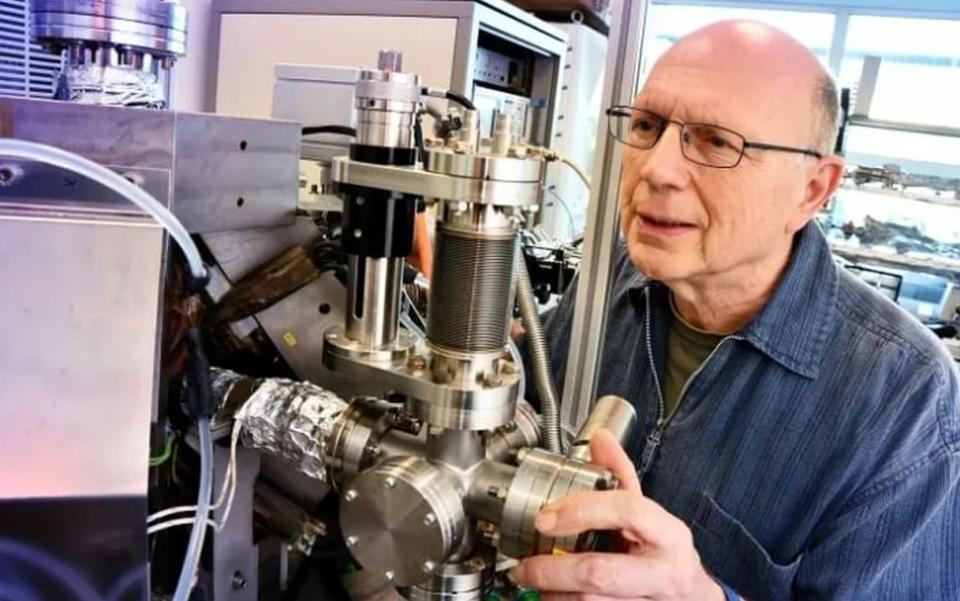A pivotal moment in his career occurred around the turn of the century while working at the Synchrotron Radiation Source (SRS) at Daresbury Laboratory. At that time, Gerrit was among the first to recognise and exploit the immense potential of resonant magnetic scattering using soft X-rays. This energy range is particularly effective because it aligns with strong absorption resonances, leading to greatly enhanced and highly dichroic signals. Magnetic multilayers, essential for spintronics, offered the perfect length scale to observe magnetic Bragg peaks when tuned to the transition-metal L edges, providing element-specific magnetic contrast. Using the dedicated high-vacuum diffractometer "Diffy," he performed groundbreaking measurements with polarised soft X-rays to probe nanoscale magnetic domains. One of his earliest landmark studies provided evidence for chiral magnetic domain structures in ultrathin FePd films, a discovery that laid the groundwork for the later, more widespread investigation of complex chiral spin textures like helimagnets, skyrmions, and hopfions.
The coherence of the synchrotron X-ray beam further enabled novel developments in Gerrit’s research. These advancements included tracking local magnetic reversal processes in FePd nanostripes using soft X-ray magnetic speckles. He also pioneered X-ray holography for imaging purposes, applying it to the study of single-layer nano-contact spin-transfer oscillators, magnetic droplet solitons, and the time-resolved dynamics of magnetic vortices and domain walls. These sophisticated imaging techniques provided unprecedented real-space and real-time views of magnetic phenomena.
Following the closure of the SRS, Gerrit joined Diamond Light Source in 2007, where his work continued to evolve and flourish. In collaboration with Durham University, he secured a grant to develop the RASOR (Reflectivity and Advanced Scattering from Ordered Regimes) diffractometer on the BLADE (Beamline for Advanced Dichroism Experiments) beamline. Over the past decade, his focus shifted towards REXS studies of skyrmion lattices, particularly in materials like Cu2OSeO3 in close partnership with academic teams from Oxford University and ShanghaiTech University.
His work at Diamond has been instrumental in characterising these exotic magnetic structures. For example, he extended the capabilities of REXS to investigate polar skyrmions in ferroelectric materials, using circularly-polarised X-rays and advanced modelling to study scattering by a chiral array of quadrupole moments.
I want to thank all my students, postdocs and colleagues for their invaluable work. Moving forward, our focus with CD-REXS will evolve from analysing static materials to studying the real-time dynamics of complex quantum and magnetic systems. This expansion of our capabilities will allow us to uncover new insights through advanced imaging techniques, including tomography and microscopy.
Gerrit van der Laan
His research revealed that circular dichroism (CD) in REXS allows for the direct experimental determination of the topological winding number, a fundamental property of these structures. Additionally, he showed that CD-REXS can measure the helicity angle in chiral spin structures through the "dichroism extinction effect." The shallow probing depth of soft X-rays also proved crucial for investigating surface-related phenomena, enabling the observation of a change in skyrmion helicity from Néel-type at the surface to Bloch-type in the bulk of Cu2OSeO3 over hundreds of nanometres.
These advances showcased how REXS could move beyond simply identifying a skyrmion lattice to revealing its intricate details, such as helicity, chirality, and depth-dependent variations. His team's use of REXS provided the first direct experimental observation of twisted skyrmions on the surface of a bulk crystal, overcoming the limitations of real-space imaging methods like Lorentz transmission electron microscopy (LTEM). The development of time- and spatially-resolved REXS even allowed for the observation of skyrmion crystallites rotating under a temperature gradient, revealing how these complex magnetic textures translate, rotate, and fluctuate in response to external stimuli. His influence also extends to novel topological spin textures, with his team using resonant elastic scattering to characterise the chiral bobber.
His research has consistently pushed the boundaries of what is observable with resonant X-ray scattering, leading to discoveries such as the skyrmion side-face state in chiral magnets and the evolution of emergent monopoles into magnetic skyrmion strings. The recent focus on slow equilibrium relaxation in chiral magnets, mediated by topological defects, further underscores his commitment to exploring the nuanced and complex dynamics of these systems. His collaborations extend across the globe, with studies being conducted at facilities like the SEXTANTS beamline at SOLEIL in France and the MaReS reflectometer at ALBA in Spain. This comprehensive and influential body of work makes the REXS 2025 Career Distinction Award a fitting tribute to his lasting impact.

